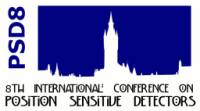Description
Applications in Nuclear Medicine and Radiology
Prof.
Alex Elliott
02/09/2008, 11:50
Applications in Nuclear Medicine and Radiology
Keynote talk
The use of imaging techniques in medicine continues to expand. Over the last decade, there has been a 30% increase in the number of investigations, with CT scans rising by almost three fold. The use of x-ray film has given way to the digital detector and companies strive for continuous improvement in both resolution and sensitivity. The latter is particularly important in terms of reducing...
Prof.
Vicente Herrero-Bosch
02/09/2008, 12:30
Applications in Nuclear Medicine and Radiology
Oral Contribution
PESIC is an integrated front-end for multianode photomultiplier based nuclear imaging devices. Its architecture has been designed to improve time behavior and increase spatial resolution. Its preamplying stage introduces two main benefits: digitally programmable gain adjustment for every photomultiplier output, and isolation from other front-end electronics by means of current buffers. This...
Dr
Martinez-Davalos
02/09/2008, 13:50
Applications in Nuclear Medicine and Radiology
Oral Contribution
A computed microtomography system (microCT) based on a CMOS flat panel detector (FPD) has been recently developed at Instituto de Fisica, UNAM, and is currently being characterised. The initial tests include the measurement of X-ray spectra using a CdTe detector, and the determination of the image transfer characteristics of the flat panel detector, such as linearity of response, MTF, noise...
Mr
Andrea Mattera
02/09/2008, 14:10
Applications in Nuclear Medicine and Radiology
Oral Contribution
Boron Neutron Capture Therapy (BNCT) is a radiotherapic technique exploiting the alpha particles produced after the irradiation of the isotope 10 of boron with thermal neutrons in the capture reaction ^{10}B(n,alpha)^{7}Li. It is used to treat tumours that for their features (radioresistance, extension, localization near vital organs) cannot be treated through conventional photon-beams...
Prof.
Robert Ott
(Institute of Cancer Research)
02/09/2008, 14:30
Applications in Nuclear Medicine and Radiology
Oral Contribution
Three different Active Pixel Sensors provided through the MI-3 collaboration have been tested to assess their application to Nuclear Medicine Imaging. When coupled to a phosphor such as CsI(Tl) these sensors have the potential for high resolution imaging of radiotracers such as Tc-99m. The work carried out so far shows that the noise levels in the APS sensors needs to be as low as possible so...
John Osmond
02/09/2008, 14:50
Applications in Nuclear Medicine and Radiology
Oral Contribution
The intelligence, read-out speed, radiation hardness and large size of CMOS active pixel sensors (APS) gives them a potential advantage over current radiotherapy verification systems. This work investigates the feasibility of using an APS to image the megavoltage treatment beam produced by a linear accelerator, and demonstrates the logic which may be used to evaluate treatment and track motion....

